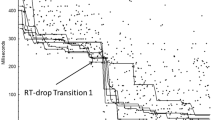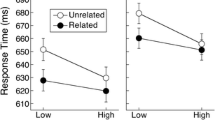Abstract
Destrebecqz and Cleeremans (Psychon Bull Rev 8:343–350, 2001; Attention and implicit learning. John Benjamins Publishing Company, Amsterdam, pp 181–213, 2003) reported that increasing the response–stimulus interval (RSI) during incidental sequence learning improved participants’ ability to discriminate old and new sequences in a recognition test. However, the original experimental design confounded RSI effects during training and test. I therefore repeated the experiment with an improved design in which RSI was varied systematically during the training phase and the recognition task. Participants learned a sequence of response locations either incidentally or intentionally. As a result, sequence recognition was not affected by the RSI manipulations in the group of incidental learners. With intentional learning instructions, recognition was unaffected by training RSI, but a long RSI in the test phase improved recognition performance over a short RSI. Response latencies while executing the test sequences indicated no effect of training RSI on sequence learning. However, sequence knowledge was expressed more readily when the RSI in the test phase matched the RSI in the training phase.




Similar content being viewed by others
Notes
In addition to a recognition test each participant performed two versions of a free-generation task which involved manual reproduction of the training sequence. Since we did not include a generation task in our own study, we will focus on recognition test results in the remainder of this report.
Welch’s (1947) t test was used for the 0-ms training RSI condition because equality of variance could not be assumed.
A six-point rating scale is commonly used in studies of sequence recognition (e.g., Destrebecqz & Cleeremans, 2001; Norman et al., 2006; Rünger, Nagy, & Frensch, 2009; Shanks & Johnstone, 1999; Shanks & Perruchet, 2002), but there is the valid concern that this scale does not meet the psychometric requirements for parametric analysis. I therefore analyzed recognition judgments with the sensitivity index d′ from signal-detection theory (Macmillan & Creelman, 1991) as the dependent variable. In an ANOVA with the between-subjects variables instruction, training RSI, and recognition RSI, the only significant effect was that of instruction, F(1, 181) = 6.07, MSE = 0.72. In particular, the Instruction × Recognition RSI interaction failed to reach significance, F(1, 181) = 1.91, MSE = 0.72, P = 0.17. Nevertheless, the pattern of mean d′ values was in close agreement with the pattern of mean recognition ratings (cf. Fig. 4). Pooled across recognition test RSIs, mean d′ was numerically lower with the 500-ms training RSI than with the 0-ms RSI for both incidental learners (0.37 vs. 0.53) and intentional learners (0.73 vs. 0.78). Thus, there was no indication that a longer training RSI improved sequence recognition. Pooled across training RSIs, incidental learners performed slightly worse with the 500-ms recognition RSI than with the 0-ms RSI (0.38 vs. 0.51). In contrast, sequence discrimination of intentional learners was better with the long recognition RSI (0.86 vs. 0.65).
References
Ashby, F. G., & Ell, S. W. (2002). Single versus multiple systems of learning and memory. In H. Pashler & J. Wixted (Eds.), Stevens’ handbook of experimental psychology (3rd ed.), Vol. 4: Methodology in experimental psychology (pp. 655–691). Hoboken, NJ, US: John Wiley & Sons Inc.
Atkinson, R. C., & Juola, J. F. (1974). Search and decision processes in recognition memory. In D. H. Krantz, R. C. Atkinson, R. D. Luce, & P. Suppes (Eds.), Contemporary development in mathematical psychology: Learning, memory, and thinking (pp. 243–293). New York: Freeman.
Buchner, A., Steffens, M. C., Erdfelder, E., & Rothkegel, R. (1997). A multinomial model to assess fluency and recollection in a sequence learning task. Quarterly Journal of Experimental Psychology. A, Human Experimental Psychology, 50, 631–663. doi:10.1080/027249897392053.
Clapper, J. P., & Bower, G. H. (2002). Adaptive categorization in unsupervised learning. Journal of Experimental Psychology. Learning, Memory, and Cognition, 28, 908–923. doi:10.1037/0278-7393.28.5.908.
Cleeremans, A. (2006). Conscious and unconscious cognition: A graded, dynamic perspective. In Q. Jing, M. R. Rosenzweig, G. d’Ydewalle, H. Zhang, H.-C. Chen, & C. Zhang (Eds.), Progress in psychological science around the world: Vol. 1. Neural, cognitive, and developmental issues (pp. 401–418). Hove, U.K.: Psychology Press.
Cleeremans, A., & Jiménez, L. (2002). Implicit learning and consciousness: A graded, dynamic perspective. In R. M. French & A. Cleeremans (Eds.), Implicit learning and consciousness (pp. 1–40). Hove, UK: Psychology Press.
Correa, Á., Lupiáñez, J., & Tudela, P. (2006). The attentional mechanism of temporal orienting: Determinants and attributes. Experimental Brain Research, 169, 58–68. doi:10.1007/s00221-005-0131-x.
Curran, T. (1997). Effects of aging on implicit sequence learning: Accounting for sequence structure and explicit knowledge. Psychological Research/Psychologische Forschung, 60, 24–41. doi:10.1007/BF00419678.
Destrebecqz, A., & Cleeremans, A. (2001). Can sequence learning be implicit? New evidence with the process dissociation procedure. Psychonomic Bulletin & Review, 8, 343–350. doi:10.3758/BF03196171.
Destrebecqz, A., & Cleeremans, A. (2003). Temporal effects in sequence learning. In L. Jiménez (Ed.), Attention and implicit learning (pp. 181–213). Amsterdam, Netherlands: John Benjamins Publishing Company.
ErEl, H., & Meiran, N. (2011). Mindset changes lead to drastic impairments in rule finding. Cognition, 119, 149–165. doi:10.1016/j.cognition.2011.01.002.
Frensch, P. A., Haider, H., Rünger, D., Neugebauer, U., Voigt, S., & Werg, J. (2003). The route from implicit learning to verbal expression of what has been learned: Verbal report of incidentally experienced environmental regularity. In L. Jiménez (Ed.), Attention and implicit learning (pp. 335–366). Amsterdam, Netherlands: John Benjamins Publishing Company.
Frensch, P. A., Lin, J., & Buchner, A. (1998). Learning versus behavioral expression of the learned: The effects of a secondary tone-counting task on implicit learning in the serial reaction task. Psychological Research/Psychologische Forschung, 61, 83–98. doi:10.1007/s004260050015.
Frensch, P. A., & Miner, C. S. (1994). Effects of presentation rate and individual differences in short-term memory capacity on an indirect measure of serial learning. Memory & Cognition, 22, 95–110. doi:10.3758/BF03202765.
Frensch, P. A., Wenke, D., & Rünger, D. (1999). A secondary tone-counting task suppresses expression of knowledge in the serial reaction task. Journal of Experimental Psychology. Learning, Memory, and Cognition, 25, 260–274. doi:10.1037/0278-7393.25.1.260.
Gaillard, V., Vandenberghe, M., Destrebecqz, A., & Cleeremans, A. (2006). First- and third-person approaches in implicit learning research. Consciousness and Cognition: An International Journal, 15, 709–722. doi:10.1016/j.concog.2006.08.001.
Haider, H., & Frensch, P. A. (2005). The generation of conscious awareness in an incidental learning situation. Psychological Research/Psychologische Forschung, 69, 399–411. doi:10.1007/s00426-004-0209-2.
Haider, H., & Frensch, P. A. (2009). Conflicts between expected and actually performed behavior lead to verbal report of incidentally acquired sequential knowledge. Psychological Research/Psychologische Forschung, 73, 817–834. doi:10.1007/s00426-008-0199-6.
Jacoby, L. L. (1991). A process dissociation framework: Separating automatic from intentional uses of memory. Journal of Memory and Language, 30, 513–541. doi:10.1016/0749-596X(91)90025-F.
Macmillan, N. A., & Creelman, C. D. (1991). Detection Theory: A User’s Guide. New York: Cambridge University Press.
Mandler, G. (1980). Recognizing: The judgment of previous occurrence. Psychological Review, 87, 252–271. doi:10.1037/0033-295X.87.3.252.
Miyawaki, K. (2006). The influence of the response-stimulus interval on implicit and explicit learning of stimulus sequence. Psychological Research/Psychologische Forschung, 70, 262–272. doi:10.1007/s00426-005-0216-y.
Nissen, M. J., & Bullemer, P. (1987). Attentional requirements of learning: Evidence from performance measures. Cognitive Psychology, 19, 1–32. doi:10.1016/0010-0285(87)90002-8.
Nobre, A. C. (2001). Orienting attention to instants in time. Neuropsychologia. Special Issue: Imaging Selective Attention in the Human Brain, 39, 1317–1328. doi:10.1016/S0028-3932(01)00120-8.
Norman, E., Price, M. C., & Duff, S. C. (2006). Fringe consciousness in sequence learning: The influence of individual differences. Consciousness and Cognition: An International Journal, 15, 723–760. doi:10.1016/j.concog.2005.06.003.
Norman, E., Price, M. C., Duff, S. C., & Mentzoni, R. A. (2007). Gradations of awareness in a modified sequence learning task. Consciousness and Cognition: An International Journal, 16, 809–837. doi:10.1016/j.concog.2007.02.004.
Perruchet, P., & Amorim, M. A. (1992). Conscious knowledge and changes in performance in sequence learning: evidence against dissociation. Journal of Experimental Psychology. Learning, Memory, and Cognition, 18, 785–800. doi:10.1037/0278-7393.18.4.785.
Perruchet, P., & Vinter, A. (2002). The self-organizing consciousness. Behavioral and Brain Sciences, 25, 297–388. doi:10.1017/S0140525X02000067.
Reed, J., & Johnson, P. (1994). Assessing implicit learning with indirect tests: Determining what is learned about sequence structure. Journal of Experimental Psychology. Learning, Memory, and Cognition, 20, 585–594. doi:10.1037/0278-7393.20.3.585.
Rose, M., Haider, H., & Büchel, C. (2010). The emergence of explicit memory during learning. Cerebral Cortex, 20, 2787–2797. doi:10.1093/cercor/bhq025.
Rose, M., Haider, H., Weiller, C., & Büchel, C. (2004). The relevance of the nature of learned associations for the differentiation of human memory systems. Learning & Memory, 11, 145–152. doi:10.1101/lm.67204.
Rünger, D., & Frensch, P. A. (2008). How incidental sequence learning creates reportable knowledge: The role of unexpected events. Journal of Experimental Psychology. Learning, Memory, and Cognition, 34, 1011–1026. doi:10.1037/a0012942.
Rünger, D., & Frensch, P. A. (2010). Defining consciousness in the context of incidental sequence learning: Theoretical considerations and empirical implications. Psychological Research/Psychologische Forschung, 74, 121–137. doi:10.1007/s00426-008-0225-8.
Rünger, D., Nagy, G., & Frensch, P. A. (2009). Do recognition and priming index a unitary knowledge base? comment on Shanks et al. (2003). Journal of Experimental Psychology. Learning, Memory, and Cognition, 35, 572–585. doi:10.1037/a0014543.
Shanks, D. R. (2005). Implicit learning. In K. Lamberts & R. L. Goldstone (Eds.), Handbook of cognition (pp. 202–220). London: Sage.
Shanks, D. R., & Johnstone, T. (1999). Evaluating the relationship between explicit and implicit knowledge in a sequential reaction time task. Journal of Experimental Psychology. Learning, Memory, and Cognition, 25, 1435–1451. doi:10.1037/0278-7393.25.6.1435.
Shanks, D. R., & Perruchet, P. (2002). Dissociation between priming and recognition in the expression of sequential knowledge. Psychonomic Bulletin & Review, 9, 362–367.
Shanks, D. R., Rowland, L. A., & Ranger, M. S. (2005). Attentional load and implicit sequence learning. Psychological Research/Psychologische Forschung, 69, 369–382. doi:10.1007/s00426-004-0211-8.
Shanks, D. R., Wilkinson, L., & Channon, S. (2003). Relationship between priming and recognition in deterministic and probabilistic sequence learning. Journal of Experimental Psychology. Learning, Memory, and Cognition, 29, 248–261. doi:10.1037/0278-7393.29.2.248.
Shin, J. C. (2008). The procedural learning of action order is independent of temporal learning. Psychological Research/Psychologische Forschung, 72, 376–386. doi:10.1007/s00426-007-0115-5.
Sun, R., Merrill, E., & Peterson, T. (2001). From implicit skills to explicit knowledge: A bottom-up model of skill learning. Cognitive Science, 25, 203–244. doi:10.1016/S0364-0213(01)00035-0.
Thurstone, L. L., & Thurstone, T. G. (1941). Factorial Studies of Intelligence (Psychometric Monographs No. 2). Chicago: University of Chicago Press.
Welch, B. L. (1947). The generalization of ‘Student’s’ problem when several different population variances are involved. Biometrika, 34, 28–35. Retrieved at http://www.jstor.org/stable/2332510.
Willingham, D. B. (1998). A neuropsychological theory of motor skill learning. Psychological Review, 105, 558–584. doi:10.1037/0033-295X.105.3.558.
Willingham, D. B., Greenberg, A. R., & Thomas, R. C. (1997). Response-to-stimulus interval does not affect implicit motor sequence learning, but does affect performance. Memory & Cognition, 25, 534–542. doi:10.3758/BF03201128.
Willingham, D. B., Salidis, J., & Gabrieli, J. D. E. (2002). Direct comparison of neural systems mediating conscious and unconscious skill learning. Journal of Neurophysiology, 88, 1451–1460.
Woltz, D. J., Bell, B. G., Kyllonen, P. C., & Gardner, M. K. (1996). Memory for order of operations in the acquisition and transfer of sequential cognitive skills. Journal of Experimental Psychology. Learning, Memory, and Cognition, 22, 438–457. doi:10.1037/0278-7393.22.2.438.
Woltz, D. J., Gardner, M. K., & Bell, B. G. (2000). Negative transfer errors in sequential cognitive skills: Strong-but-wrong sequence application. Journal of Experimental Psychology. Learning, Memory, and Cognition, 26, 601–625. doi:10.1037/0278-7393.26.3.601.
Yonelinas, A. P. (1994). Receiver-operating characteristics in recognition memory: Evidence for a dual-process model. Journal of Experimental Psychology. Learning, Memory, and Cognition, 20, 1341–1354. doi:10.1037/0278-7393.20.6.1341.
Yonelinas, A. P. (2002). The nature of recollection and familiarity: A review of 30 years of research. Journal of Memory and Language, 46, 441–517. doi:10.1006/jmla.2002.2864.
Acknowledgments
This research was supported by NIH Grant P01 NS044393.
Author information
Authors and Affiliations
Corresponding author
Rights and permissions
About this article
Cite this article
Rünger, D. How sequence learning creates explicit knowledge: the role of response–stimulus interval. Psychological Research 76, 579–590 (2012). https://doi.org/10.1007/s00426-011-0367-y
Received:
Accepted:
Published:
Issue Date:
DOI: https://doi.org/10.1007/s00426-011-0367-y




